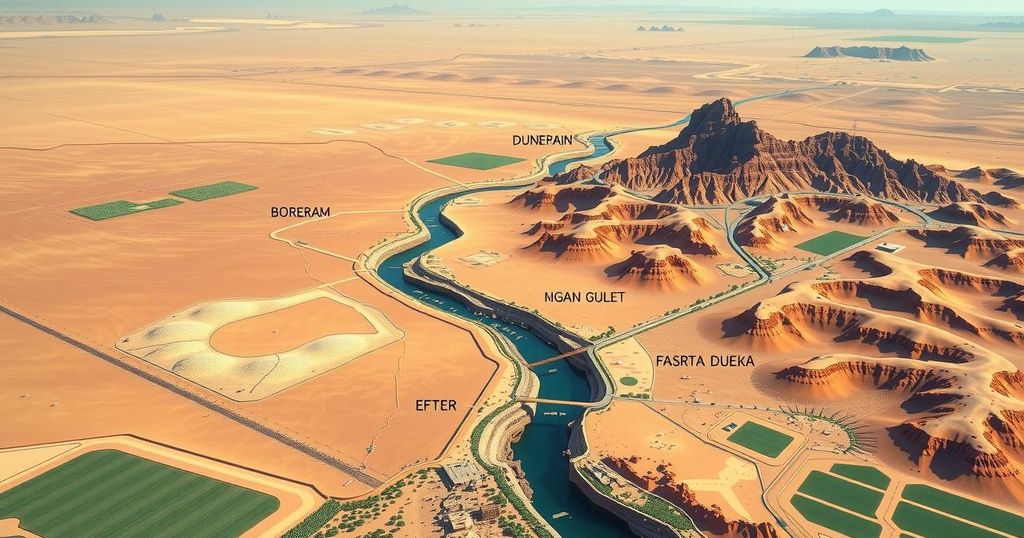Voluntary Land Swaps: A Path to Stability in the Middle East

Voluntary land swaps between Jordan and Israel emerge as a potential path to regional stability amid new threats from Iran and extremist groups. The geopolitical context, marked by shifting alliances and Jordan’s precarious situation, suggests a historical opportunity for realignment. Supported by leadership like President Trump, the proposal could enhance defenses and stimulate economic growth, transforming the regional landscape.
In light of recent developments, discussions about voluntary land swaps in the Middle East surface with renewed significance. The turbulent nature of historical borders implies that a realignment might serve the interests of Jordan, Israel, and neighboring countries, particularly given the current geopolitical climate. Factors such as the collapse of the Syrian regime, increased threats from Iran and Turkey, and the past leadership of President Donald Trump create a unique context for potential border changes.
Jordan, a close ally of the United States, finds itself facing significant challenges posed by various hostile forces to its north and east. The kingdom was, after all, established following the French dismantlement of the Arab Kingdom of Syria in 1920, which led to the depopulation of its Hashemite rulers. The historical dynamics have shifted dramatically, as Jordan’s primary threat now stems from forces like Iran and Sunni extremism, rather than from Israel.
Historically, Jordan interacted with Israel as an adversary during violent conflicts back in 1948 and 1967, while the northern borders remained fairly stable. Nowadays, however, regional alliances have altered; Jordan now relies on Jerusalem as an ally. With Iran, ISIS, and other militant factions looming at its borders, it appears Jordan’s defensive strategy must evolve to address these new threats.
To adapt to the evolving regional threats, the idea of acquiring territory in southern Syria appears compelling for Jordan. A territory swap could provide Jordan a strategic foothold while increasing its size and influence, essentially reawakening its historical ties to southern Syria. This realignment could also permit Jordan to reclaim a prominent role in the Gulf while potentially creating economic opportunities that have been previously out of reach.
Conversely, Israel’s position remains precarious, as historical vulnerabilities have resurfaced. The vulnerability of the long, porous border with Jordan has been underscored by the recent surge of violence from forces like Hamas. If Hamas could cross over populated areas to reach Israel, an organized military force from Jordan presents an even more significant threat without such geographic barriers. Thus, Israel continuously reevaluates its defense strategies in relation to Jordan’s borders.
Land swaps, while complex, are not new concepts. They have flourished throughout history, and utilizing voluntary agreements can lead to long-term stability. Many have argued that shifting Israel’s defensive line eastward represents the most effective and pragmatic solution to current security dilemmas. Establishing a strong defensive presence in southern Syria could thwart potential invasions and ultimately ensure the survival of both Jordan and Israel.
Beyond military strategy, a land swap could foster economic rejuvenation in the region. Envisioning a “California of the Middle East,” it appears feasible to promote agricultural development with a transformed land strategy. Such initiatives may be approachable by 2025, aligning with potential investments comparable to a “Marshall plan” in the Middle East aimed at revitalization.
No significant population movements would be necessary for such a swap, which adds to its attractiveness. The idea respects current demographics, allowing Syrians and Jordanians to remain in their homes while fortifying defenses against mutual threats. Proponents argue that such a shift could reduce opposition to a Palestinian state by establishing critical buffer zones.
Of course, navigating these politically sensitive discussions must occur away from the limelight, involving strong leadership capable of forging effective agreements. Currently, leaders like Trump have shown the potential to bridge gaps and bring unity to negotiations. His robust relationship with Arab leaders underscores this potential, forcing a reevaluation of longstanding divides that have historically fueled conflict.
In summation, as the geopolitical landscape in the Middle East shifts, the viability of voluntary land swaps deserves serious consideration. The convergence of economic and military imperatives creates an opportunity to revisit borders in a way that could yield mutual benefits and ensure long-term regional stability. The ongoing leadership’s role is pivotal in this complex negotiation process, and a keen focus on the future may lead to transformative agreements that reshape the Middle East altogether.
In summary, the prospect of voluntary land swaps in the Middle East presents an intriguing avenue toward bolstering regional stability. Both Jordan and Israel could benefit from strategic border realignments, particularly to address current and emerging threats from neighboring extremist groups. A well-negotiated swap could also open the door to economic opportunities and reinforce defenses for the involved nations. Overall, this is a dynamic framework that requires strong leadership to navigate successfully and could usher in a new era for the region.
Original Source: www.jpost.com







